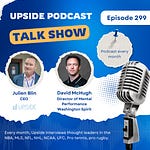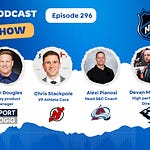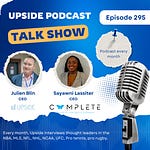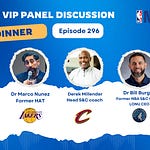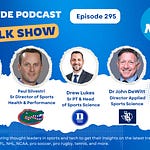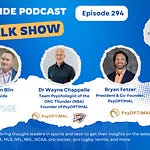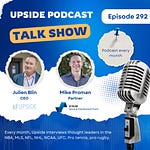This week we had the honor to interview Mert Ergeneci, co-founder of Neurocess, a leading sports tech startup that produces sensors to assess injuries.
Here is a video illustrating Neurocess’ sensor based solution to assess players’ injuries.
Video: Neurocess
Neurocess offers services as a wearable technology product that increases the training performance and reduces the risk of injury. Its product provides a sports activity analysis platform through a wireless EMG-based sensor network optimized for athletes. The developed bio-sensors is assisted by advanced signal processing methods to capture physiological data from the muscles accurately. They are using the electrical signals to extract important physiological and biomechanical features such as localized muscular strength, force, fatigue level, dehydration, conductivity, muscular stiffness, muscle recruitment with respect to time.
Picture: Neurocess
📝Show Notes: Through this interview, we touched on his background and how he got the idea of his company. We also discussed his role at Neurocess, his product and the benefits for the teams. And then we touched on his plans for the next 12 months.
🚀Best Quotes: Here’s some of the key discussion points and best quotes from our conversation with Mert:
On his background: “ I have an engineering background. I studied electronics engineering in Turkey at the University of Bilkent. And after graduation, I started the company with one of my classmates. We started the company in 2016 and we have done a lot of research and innovation since then. I am still studying as I am in my final year in King's College where I am doing a PhD on machine learning and EMG Sensors. So it's quite related to the topic that I am doing with my company”.
On how he got the idea of launching Neurocess: “In our senior year, at the university, we were working with the biosensors and we thought that it had a future. And because it was capturing too much information from the human physiology, what we saw was that, even though the sports industry was investing too much on different technologies, they didn't invest on the data and these kind of physiological sensors. There was a big gap there because they were losing too much money because of injuries or the lack of measurements or wrong measurements. So we said to ourselves, let's apply this tech to the sports sector and see what happens because we foresee that data in football and in other sports was emerging. So that's why we wanted to apply our knowledge about biosensors to the sports field in order to tailor it specific to the sports field. That's how Neurocess started. Our company headquarter is in London (..) We have some full-time and part-time employees. Right now we have 10 people on our team”.
On their EMG based product: “What we do is EMG and it's the abbreviation for electromyography and it's like electrocardiograph or EEG. We basically measure the electrical signals transferred on the muscles. So how this happens is when a certain individual wants to make a certain activity, the brain sends some firing impulses, some electrical impulses through the spinal cord, to the muscle fibers and those electrical signals accumulate on the muscle. And these sensors just measure it in a certain way. So our sensors collect the data, those electrical signals in a really correct way so that we can process that data and extract information. We can extract all the physiological information like muscle fatigue, muscle contraction rates, the balance between muscles, or the lactate accumulation on the muscles, the strength, and many more information like these. So we use that information extracted from the muscles and analyze further in a way that is specific to the sports field like hamstring injury risks, or the load on hamstrings, the imbalance or the asymmetries, how the person is being recovered, or how the performance of a person is getting much better or worse”.
On the benefits for teams to use their product for pre-injury purposes: “Currently there are two use cases for our product. One is pre-injury and one is post-injury. So in the case of pre-injury we mostly collect data from the players. We work with soccer clubs in the Premier League. For the pre-injury analysis we take match day minus two measurements from eight different muscle groups of all the players who are going to play in the match day. And then match day plus two data. So two days before the match day and two days after the match day. And by this day we assess the load of the game played on the players. And then we track the amount of load and how much they recovered from the game. So by this day we kind of give the teams certain insights, how much they should load the players during the training. And if there's an anomaly or a problem with a certain player, we also warn them that there's a player whose muscles are not doing well, and who can have a risk of injury. So we inform the clubs that way”,
On the benefits for teams to use their product for post-injury purposes: “The second use case is the post-injury. No matter what you do, and I'm just warning everybody because we did lots of research on injury prevention, if any company says that they can prevent injuries fully, you have to be skeptical because it's impossible to truly prevent injuries. There will always be some variations. Even the food that they eat, or the mentality that they have can impact an injury. And clubs also use our product for post-injury analytics. So how do they use this during the rehab process? We actually track the return to play of the players and athletes. So we can tell the clubs if a player is ready to return to play. Or if it is too early to return to play. For example we can just tell the club that there can be a certain recurrence of a certain injury and if it's too early for a player to return to play. And we can also tell teams sometimes to have a couple more rehab sessions and wait a couple of more days to be completely sure that the player is not returning too early. Because returning early can trigger the re-injury and the player's market value can just drop radically. That's a really a bad thing because when a certain injury appears consecutively that statistically proves that a player will have the same hamstring injury every year and the market value will decreases accordingly. So we have to be careful and carefully analyze the data. And that's also what we do with post-injury tracking”.
On how their product is different from the competition: “ There are two types of EMG devices available in the market right now. One is the clinical grade EMGs that are surface EMGs. They are wireless like ours. In this case, the data is transferred wirelessly to a user interface, and you can see the output. And the second type of EMG devices are the ones that have embedded conductive garments. In that case they are not active. They are just passive EMGs. They're basically passive conductive materials that are embedded and tailored to the compressive garments. So as a player you basically have to wear the short (embedded with EMGs) and the data is stored. We are different from that as we are closer to the clinical grade EMG because we actually validated our sensors with a lot of academic papers. This is why we have the clinical grade EMGs and others do not. And the difference of ours versus those clinical grade EMGs is that those clinical grade EMGs are made for hospitals and research groups. They're not tailored to sports and team sports. And the hardware is not making noise cancellation. In sports, there's always huge motion that can cause noises in the EMG signal, which impacts the quality of the signal. So those clinical grade EMG sensors do not do any noise cancellation (..) In our case we get lots of good insights from the raw data and the complex signal. And we visualize that information specifically for the needs of sports labs, physios, or strength and conditioning coaches”.
On the fact that their sensor can be applied directly on the player’s skin, measures various types of muscles and does not require athletes to wear a compression short or shirt: “We have been working with the Premier League clubs for the last three years. And I have never seen a case where you ask a player to get naked and wear a compressive garment just in front of a physiotherapist. It is quite impossible to convince a Premier League player to do that. So it's not feasible for a player to wear that every time after a game or in the morning in the physio session. And the second problem is the limitation with the muscles they measure. So we purchased a lot of competing products, and we looked under the hood and actually saw that they do measure only specific muscle groups. So for example, they can only measure one muscle group such as the quadriceps. And there's always crosstalk because they not only measure a specific muscle group from quadriceps, but they also have big stripes of conductive threads on the quadriceps. And they don't measure, for example, specific muscles like adductor longus, adductor magnus, or many more TFLs or specific muscles. So with our solution any physiotherapists can put our sensors on any specific muscle groups and they can select it from our user interface. So our product is not limited to muscle groups. And there's a big benefit of that because the problem can be related to vastus medialis, from the quadriceps rectus femoris. But with those variables, you don't know the problem because you just measure all the muscles together. And the other problem with the variable garments is that their conductivity is changing and deteriorating over time. As a result of that, the product is not stable and reliable, especially if you wash the garment over time”.
On issues with other EMG products like Athos or Myontec: “There was a company called Athos. They were the second company to use EMGs after Myontec I believe. I have read a lot of complaints about those products. For examples users said that the muscles are not being measured (through those products) after 20 wash cycles. And the issue with the conductive thread is that they get too much sweat, and they get stretched because you stretch the threads, so the conductivity of that garment is not kept stable once the garment gets washed 20, 30 times. And it typically happens within two months. So if you use it every two days, then the product will provide different information over time. And if you have a really small conductivity after a month, you will see that the muscle is getting much lower amplitude and lower strength in that period of time. Then as an athletic trainer you will think that the player is giving less power. But that’s not the case because the conductor is changing. And it's a really big issue. The last issue with these products is that because they have a passive electrode, they don't put an EMG directly on top of the muscle. As a result of that they get the really low EMG signal. They also have lots of noise, interference and motion, and it's impossible to specifically extract EMG from there. It's really, really difficult (..) So with that low quality data, you can only see things like how much your left and right muscle activated, but you cannot get more advanced analytics, like the fatigue level, the dehydration and lactate level, or the asymmetries. And you cannot see the difference between the eccentric and concentric contractions with this low quality data”.
On how Neurocess can analyze 10 types of parameters and assess injuries: “We visualize 10 different types of parameters in real time and we can see how players are getting close to a potential injury or how far away they are from the injury. So what we do is data visualization and how we do it is use our neural networks that work in four different dimensions (..) we basically take to Euclidean distance to the injury or to the fully fit version of a player. So if the player has a stiffness and just says “okay I'm feeling pain in my biceps femoris they just make the measurements and then say, "Okay, you are just close to your injury by 80%. You're close to your injury by 80% as of the 3rd of August." So we track that because we have all the data related to past injuries or the fully fit versions of the players. And by looking at it in 10 different dimensions, we just visualize it”.
On the fact that they use WiFi to connect the sensors: “We use WiFi to connect our sensors, and we have a patent pending currently which will allow us to optimize the Wi-Fi power consumption to a level that is close to Bluetooth in these EMG applications”.
On their business model and the free trial that they offer to teams: “We have a subscription based business model. So we essentially give away our hardware, and we just offer our product through different packages. It starts from a 1000 pounds per month to 1700 pounds per month. The pricing depends on the package the team select. And the packages are different depending on the types of reports that the clubs want. These reports can be more customizable and more advanced or we can also provide more basic types of reports. It is also dependent on the analytics required on the software, but the hardware is the same. So to summarize we just give away the hardware, charge a monthly fee to the clubs for the analytics and software. We also provide a one month free trial or six sessions of analytics of a recovery or player post-match day. So if you do six measurements, you can choose either one of them. If you say, I will not be able to do six sessions in a month we can accommodate you as well. You can just try the product, see the reports and how it can benefit you and then you can subscribe to our product if you want to”.
On the type of clubs they work with: “We are a UK based company and we have been in touch with all the Premier League clubs for more than three years. And we have been building case studies with them and working with them very closely. We are now working with most of the Premier League clubs, but our aim is to expand to the other European soccer leagues. We started doing some trials with some Spanish and French football clubs. And hopefully we will expand to Germany and Italy, and we are also doing trials with some Turkish clubs”.
On their plans for the next 12 months to expand to other geographical areas and sports: “We really want to expand to the United States and the American market. And we also do not want to stay in only one type of sports because our sensors are not limited. In fact they can be located on any muscles. And our analysis are quite generic so most of the sports fields could use and benefit from our sensors. That's why we really want to expand to new sports such as American football, rugby or basketball. We have been doing some trials with pro cycling teams. And we believe that it's the top level of human performers and we really want to explore cycling as well. We also have some good contacts in Formula One and we want to do trials with a couple of Formula One teams (..) We really would like to prove that we could be used in many other sports without any improvement on the product”.
On their plan to raise a new round of funding: “In 2008 we had a pre-seed grant of around $250k from the SOSV HAX Accelerator (..) And after that we raised $400k and now we plan to raise $4M to $5M this year”.
You may also like:
⭐ ⌚ Upside: HR/HRV Monitoring Market (Key vendors, Trends & Recommendations to Teams)
🔮 2022 Upside Top Sports Tech Predictions (NFT/Metaverse, Sports Performance, IPOs/M&As..)
🔥 Upside Chat: Sean Harrington, Notemeal CEO (Online platform for nutritionists and dietitians)





